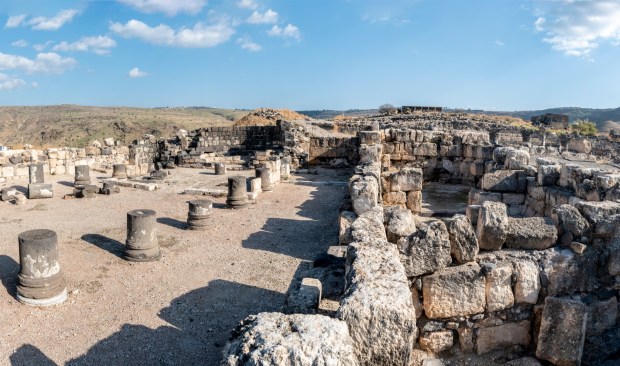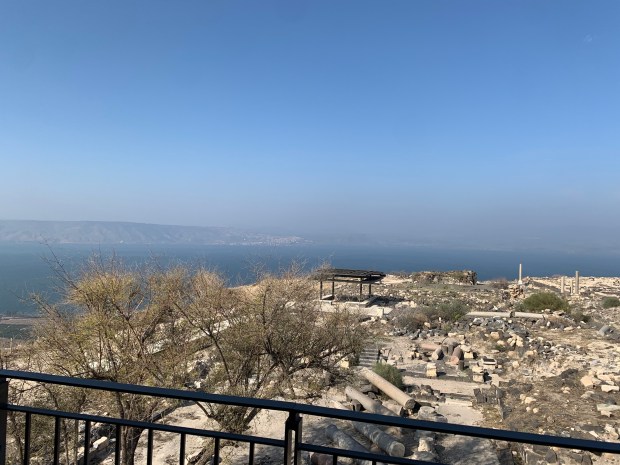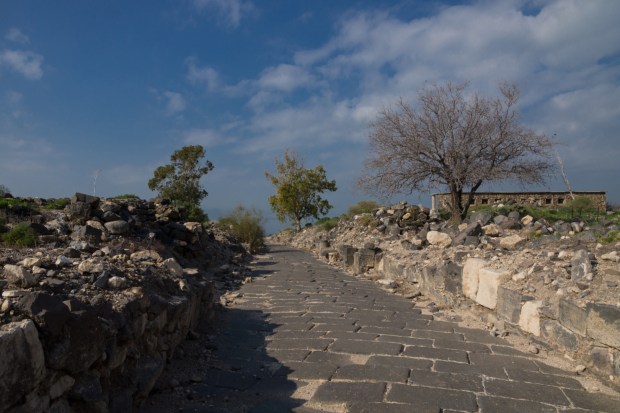A city built on a hill cannot be hid. According to the Gospel (Mt. 5:14), Jesus said these words as he stood on the Har HaOsher, the Mount of Beatitudes, on the northwestern shore of the Sea of Galilee. From there, on the opposite shore of the sea, a splendorous city could then be seen, its palaces and columns standing out and shining under the sun: the ancient Hippos –one of the ten cities of the Decapolis, the famous league of Hellenistic cities (hence the deca prefix) formed after the Roman conquest of the region, to “romanize” the Semitic peoples of the region.
Thanks to Mark, we know that Jesus visited some of the cities of the Decapolis more than once. These were rich, powerful cities that minted their own currency and had their own temples and amphitheaters – far different from the Jewish villages of Nazareth or Capernaum.

Some of the cities in the Decapolis are mentioned in the Gospels. One of them, Gerasa, barely two kilometers away from Hippos, is the location of the well-known “miracle of the swine.” Jesus commanded a legion of demons tormenting a man to leave the man and enter a herd of swine instead, as recounted in the three Synoptic Gospels. The swine, “numbering about two thousand” according to the Gospel of Mark (cf. Mk 5:13), “rushed down the steep bank into the sea, and were drowned in the sea.” Some scholars remark that the first apostle to the Gentiles was not Paul, but the man whom Jesus exorcised. “Go home to your friends, and tell them how much the Lord has done for you, and what mercy he has shown you.” (cf. Mk 5:19). This man’s home, according to some scholars, was Hippos.
Hippos: A city lost and found
Incredible as it may seem, the city built on a hill spent centuries hidden. A devastating earthquake buried it, almost in its entirety, in 749 AD. Uninhabited for centuries, only nomadic Bedouin tribes occasionally went through it. “The location simply fell into oblivion,” Nissim Mezig, director of the archaeological sites around the Sea of Galilee, explains to Aleteia.
It was during the war of 1967, Mezig explains, that the Israeli army rediscovered the city while occupying the Golan Heights. Its proximity to the border was precisely what prevented archaeological excavations for decades.

The area will be open to the public on March 15, with all kinds of touristic and religious facilities – restaurants and cafes, chapels, information centers, and facilities for people with special needs. It is managed by the Israeli Nature and Parks Authority, the government entity dedicated to heritage conservation and restoration.
Early Christians
Mainly due to an ongoing effort from the University of Haifa, 15 different campaigns have gradually brought the ancient city to light since the year 2000. Mezig explains that Hippos, precisely because of its sudden destruction and subsequent oblivion, is as well-preserved as Pompeii or Herculaneum. It is an exceptional sample of early Byzantine splendor: Its ruins include a major cathedral and seven smaller Byzantine churches, as well as a basilica, baths, and an important necropolis at the foot of the hill.
Yosi Bordowicz, director of the Heritage Department of the Israeli Nature and Parks Authority, told Aleteia that there are plans to propose that the Hippos archaeological park be incorporated into already existing pilgrimage routes –because of its closeness to Kursi, Capernaum, and other destinations around Lake Tiberias.

The Hippos site helps, he explains, “to understand the spread of Christianity long before it became the official religion of the Empire” – an expansion that began around this lake 2,000 years ago, and which is, unfortunately, little known by Christians nowadays.



